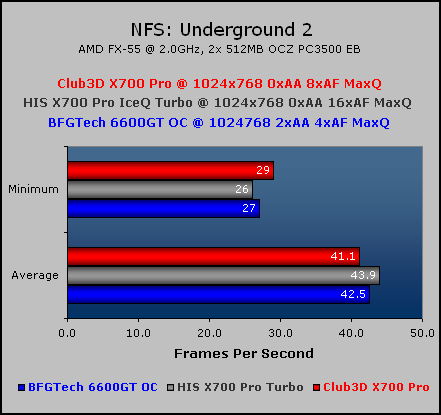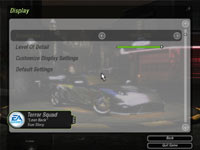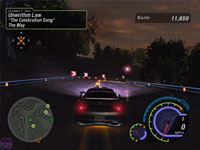Need For Speed: Underground 2
Publisher: Electronic ArtsImage Quality:
The Need For Speed: Underground 2 is a game that I’ve spent a long time playing through recently, I’ve used it here to represent a typical driving simulator - it’s based on the DirectX 9.0 API, and makes use of lots of DirectX 9.0 features, including motion blur and light trails. Anti-Aliasing was controlled from inside the game, while Anisotropic Filtering was controlled via the driver control panel, as the game does not feature adjustment for Anisotropic Filtering.
I used a 2-lap race on the "Ambassador Ridge" circuit with three opponents and traffic set to "minimum" for our manual run through. The circuit is a fairly high-speed one, so it makes good use of motion blur and light trails.
We found that 1024x768 was the optimum resolution for all video cards, but we found that both X700 Pro’s had a slight weakness with Anti-Aliasing enabled. The BFGTech 6600GT OC delivered a playable frame rate at 1024x768 2xAA 4xAF, while the Club3D and HIS X700 Pro’s were best at 1024x768 0xAA 8xAF and 1024x768 0xAA 16xAF respectively.
Despite the jaggies that we can see on the two X700 Pro’s, the quality of the ground is considerably better on the two ATI-based video cards in these static images. The blur on the BFGTech 6600GT OC does go away to an extent when you are travelling at high-speed, and I personally think that it is just related to the way that the ForceWare driver renders the bloom of light coming from the road. Increasing Anisotropic Filtering will also help matters, but we found that 2xAA was beneficial to image quality around the edges of the cars for certain. You can also notice the jaggies on the horizon of the track, just before the corner - it is a matter of personal preference, but the BFGTech 6600GT OC was capable of delivering a smooth gaming experience at 0xAA 16xAF too.
Performance:


MSI MPG Velox 100R Chassis Review
October 14 2021 | 15:04










Want to comment? Please log in.